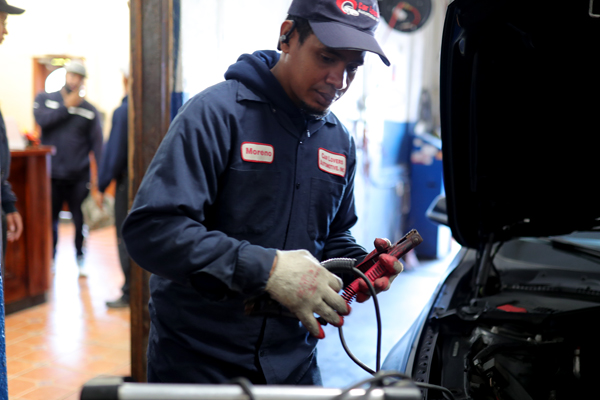All Categories
Featured
When it comes to vehicle upkeep, tires are commonly among one of the most overlooked parts, although they play an essential duty in the security and efficiency of your car. Tire turning and placement are two important services that help guarantee your tires put on uniformly, last much longer, and continue to perform at their best. Here's every little thing you require to learn about tire turning and positioning and why they matter for your vehicle.
What Is Tire Rotation? Tire turning is the procedure of moving the tires from one position to another to ensure even put on throughout all 4 tires. The front and rear tires of a vehicle wear at different rates because of the weight circulation and the fact that the front tires take care of both guiding and braking. By revolving the tires frequently, typically every 6,000 to 8,000 miles, you can cancel the wear and prolong the life of your tires.
In many cars, the tires will certainly be turned from front to back, and in some instances, side-to-side, depending on the tire kind and your car's specifications. This makes certain that each tire bears an equivalent quantity of stress and anxiety and strain. Routine tire rotations also enhance vehicle handling and ride high quality, in addition to contribute to much better fuel effectiveness.
What Is Tire Positioning? Tire alignment refers to readjusting the angles of your car's wheels to ensure they are located properly according to the maker's specs. Proper placement ensures that your tires are alongside each other and vertical to the ground, which assists improve the general handling, security, and life expectancy of your tires.
There are three vital facets of alignment:
Camber: The tilt of the wheels when seen from the front. If the wheels lean internal or outside, it can create uneven tire wear. Caster: The angle of the guiding axis when checked out from the side. Appropriate wheel alignment ensures steady steering and far better lorry control. Toe: The angle at which the tires direct inward or outside when watched from above. Incorrect toe alignment can cause tires to put on unevenly and influence dealing with. Misalignment can happen due to elements like striking pockets, aesthetics, or driving over harsh surface, and even regular driving with time can gradually trigger imbalance. Getting a positioning check every 1-2 years or when you discover taking care of problems is vital for optimal tire performance.
Why Are Tire Rotation and Placement Important? Maximized Tire Life:. Tire turning ensures also use across all 4 tires, avoiding premature tire replacement. Misaligned tires use unevenly, which can result in the need for more constant tire substitutes. Both tire turning and positioning increase the lifespan of your tires, saving you cash over time.
Improved Safety:. Appropriate alignment assists maintain your car tracking directly, enhancing stability and handling. Misaligned tires can lead to drawing, which makes it tougher to manage your lorry, particularly at high speeds or in emergency situation scenarios. Tire rotation likewise ensures your car's handling remains constant, improving your capability to quit quickly and maintain control.
Much Better Fuel Effectiveness:. When your tires are correctly aligned, they experience much less moving resistance, meaning your engine doesn't have to function as difficult to relocate the car. This lowers gas usage and boosts gas mileage. Imbalance can cause your tires to drag, bring about bad gas performance.
Smoother Adventure:. Misaligned or unevenly worn tires can create vibrations in the steering wheel or lorry body, which can be awkward while driving. Normal tire rotation and positioning can give a smoother and quieter ride, minimizing unnecessary sound and vibrations.
Indications You Required Tire Rotation or Positioning. It is necessary to be familiar with advising indications that your tires might require interest. Watch out for:
Uneven Tire Put On: If you notice that a person tire is much more worn than others, maybe an indicator that it's time for a turning or positioning. Guiding Drawing away: If your car pulls away, especially when you're driving straight, it can suggest misalignment. Vibrations or Uncommon Noises: If your wheel trembles or you listen to a humming or whimpering sound, your positioning could be off. Screeching Tires: A high-pitched screech can signal misalignment or that your tires are worn erratically. If you notice any one of these signs, it's a good idea to have your lorry evaluated asap to prevent further damages to your tires or suspension system.
How Frequently Should You Turn and Align Your Tires? Tire turning is usually suggested every 6,000 to 8,000 miles or every six months, depending upon your vehicle's guidebook and driving problems. It's also an excellent idea to rotate your tires during oil adjustments to see to it they obtain the interest they need.
For placement, many professionals recommend having your tires aligned when a year or if you notice any managing issues. If you've recently hit a pothole, visual, or an additional barrier, it's an excellent concept to have your positioning checked earlier to avoid irregular tire wear.

Verdict: Keep Your Tires for Durability and Safety and security. Tire turning and positioning are basic yet vital elements of vehicle maintenance that add to longer tire life, enhanced safety and security, and better gas performance. By complying with the advised service intervals for tire rotation and positioning, you can guarantee your tires remain in top condition, giving a smoother and much safer driving experience. Normal upkeep helps you prevent unanticipated tire wear, pricey repairs, and possible crashes, making it a wise investment for your vehicle's general efficiency.
Latest Posts
Find Budget-Friendly Auto Repairs with Montclare’s Monthly Service Specials
Explore Auto Services & More: Comprehensive Auto Care Solutions from Montclare Auto Repair
Explore the Premier Auto Repair Deals in Montclare, Chicago
More
Latest Posts
Find Budget-Friendly Auto Repairs with Montclare’s Monthly Service Specials
Explore Auto Services & More: Comprehensive Auto Care Solutions from Montclare Auto Repair
Explore the Premier Auto Repair Deals in Montclare, Chicago
